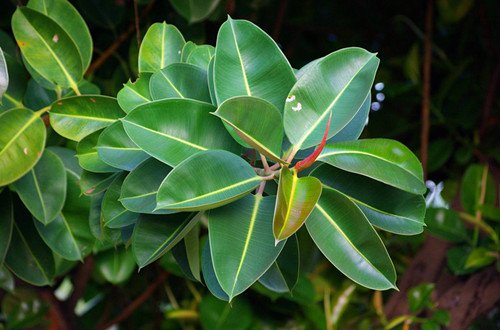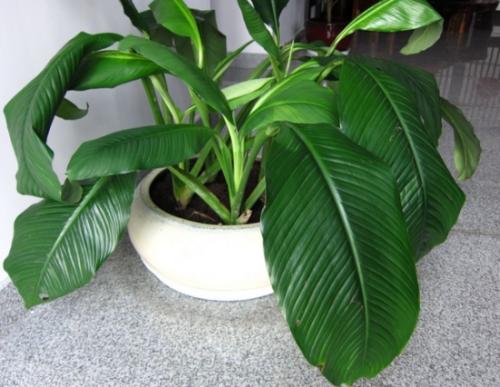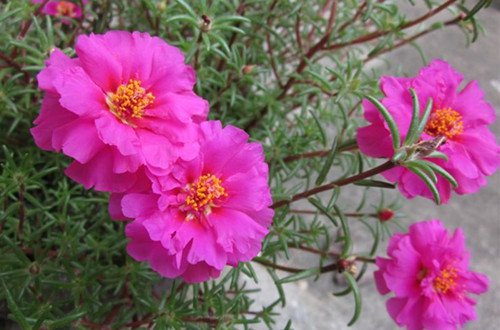How did the rubber tree lose its leaves?
Rubber tree is an evergreen foliage plant, because of its large leaves, glossy by many people like, put in the home is very lively, but at the same time there will be some minor problems, such as yellowing, falling leaves and other problems after a period of time. So, how did the rubber tree lose its leaves? What are we going to do? The following plant encyclopedia editor introduces the reasons and solutions for the loss of leaves in rubber trees.
1. Soil consolidation caused by not changing the basin for a long time

At the initial stage of rubber tree growth, the basin needs to be changed once a year, and the basin diameter is larger every year. After growing for 6 to 8 years, the basin can be changed every three years. If the basin is not changed for a long time, the basin soil will be seriously consolidated and the soil ventilation will be poor. It will cause asphyxiation and necrosis of the fibrous roots of rubber trees, unable to absorb water and nutrients, and cause plant leaves to wither and fall off.
Solution: when the temperature reaches more than 15 degrees, turn the basin, cut off the dead roots, and shake off most of the persistent soil. Remove the yellowed leaves, cut the stem properly, replace the original consolidated basin soil with fresh and fertile culture soil, and often keep the soil moist, which can promote the re-emergence of new roots, restore health, and grow into multi-branched plants. In the future maintenance, it is necessary to keep the basin soil permeable and loosen the basin soil every 15 to 20 days while keeping the basin soil moderately moist, so as to avoid rotting roots or root atrophy caused by repeated watering.
2. the temperature is on the low side
The lowest adaptive temperature of rubber tree is above 6-8 degrees. If the room temperature is less than 5 degrees in winter, the withered and yellow leaves will occur.
Solution: to increase the room temperature through the winter, be sure to keep it above 6-8 degrees.
Third, too much watering
Although the rubber tree is a water-loving plant, if it is watered too much, especially from August to September, when the weather is still muggy, it forms stagnant water in the basin; or it is overwatered during the overwintering, and the plant is in a dormant period, transpiration decreases, and the water in the basin can not be discharged in time.
Solution: first cut off the decaying root system until the wound section is fresh and white milk is oozing. Add a little more to let the wound milk dry, or smear sulfur powder on the wound, or wipe it with clean plant ash and charcoal shavings, and cut off part of the branches at the same time, so as to reduce the transpiration consumption of water, and then plant in a different pot. When replanting, it is appropriate to choose clean and slightly moist fine sand to surround the root wound, and the outside should be planted with fresh and loose sandy soil, strengthen shading and spray management, basin soil is not dry and no longer watering; as long as the plant root system is not too seriously damaged, a new tender fibrous root can be produced at the wound of the root system after a month. After maintenance, often keep the basin soil slightly moist, do not over-watering, can spray water to the leaf surface in the morning and evening.
4. Excessive fertilization or no fertilization for a long time
Rubber trees are fertilizer-loving plants, but if they apply too much fertilizer or mistakenly pour raw fertilizer, big fertilizer or thick fertilizer, they will rot their roots and lead to withered and yellow leaves due to water and fertilizer damage. If the rotten root is caused by fertilizer damage, the root will be accompanied by an unpleasant smell. In addition, not applying fertilizer for a long time will also cause malnutrition, resulting in yellowing and falling leaves.
Solution: stop fertilizing immediately and change the soil immediately. If you do not apply fertilizer for a long time, add the base fertilizer when changing the basin, remove the yellow leaves in time, and apply fertilizer once a month, mainly phosphorus and potassium fertilizer.
5. Improper ventilation
The indoor wind is different for a long time, the environment is muggy, accumulating a large number of harmful gases, even if the rubber tree has the role of purifying the air, it is difficult to face this situation.
Solution: open windows in time for ventilation and keep indoor air fresh. In winter, windows can be opened to change indoor air at noon when the temperature is higher.
Infection with Botrytis cinerea
The conservation environment is not suitable, and rubber trees are vulnerable to Botrytis cinerea, which needs timely prevention and control.
Solution: diseased leaves are removed and destroyed in time, and withered leaves are cleaned in time. Appropriately increase indoor light and increase room temperature. When diseased leaves are found, spraying 600 times of chlorothalonil wettable powder solution in time, 7: 10 can be sprayed once for 2 or 3 times in a row, which can effectively control the spread of bacteria.
[tip] Rubber tree is a tropical tree species, like plenty of sunshine, not resistant to shade, if you do not see the sun indoors for a long time, there will be the problem of yellow leaves and falling leaves. Need to be placed in a sunny place to maintain good light, the best winter can also be sunny.
Time: 2019-04-18 Click:
- Prev

How to maintain the large-scale green plants in the hulk hulk
For the hulk, flower friends should be very familiar with its cultivation, management methods and other problems of plant encyclopedia Xiaobian send their own experience summary of ornamental plant name, perennial evergreen shade herb foliage plant, short and stout stem, few tillers, plant height can reach more than 1 meter, is a large species in the taro series
- Next

What if sunflowers don't blossom?
Sunflowers like warm, sunny and dry environment, it has the habit of seeing the sun blossom, in the morning, evening, cloudy days, the flowers close, the stronger the sun, the better. Recently, some flower friends have come to ask the sunflowers at home to grow luxuriantly, but they do not bloom, so what is the reason why the sun does not blossom?
Related
- Fuxing push coffee new agricultural production and marketing class: lack of small-scale processing plants
- Jujube rice field leisure farm deep ploughing Yilan for five years to create a space for organic food and play
- Nongyu Farm-A trial of organic papaya for brave women with advanced technology
- Four points for attention in the prevention and control of diseases and insect pests of edible fungi
- How to add nutrient solution to Edible Fungi
- Is there any good way to control edible fungus mites?
- Open Inoculation Technology of Edible Fungi
- Is there any clever way to use fertilizer for edible fungus in winter?
- What agents are used to kill the pathogens of edible fungi in the mushroom shed?
- Rapid drying of Edible Fungi

